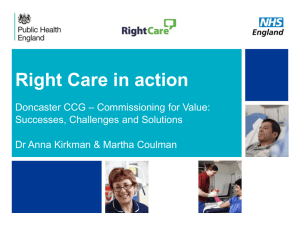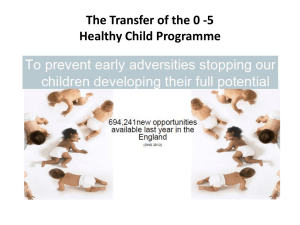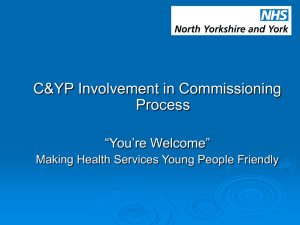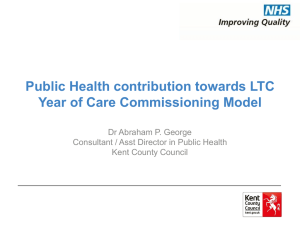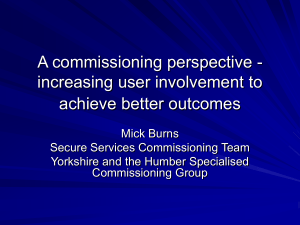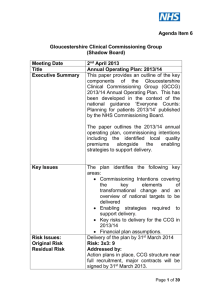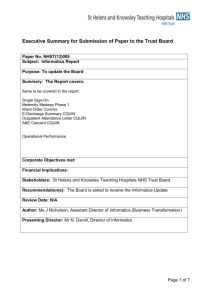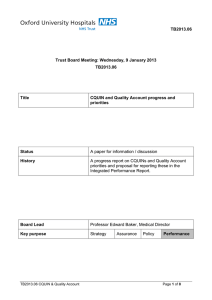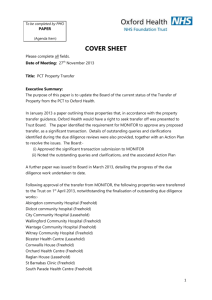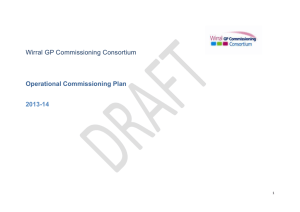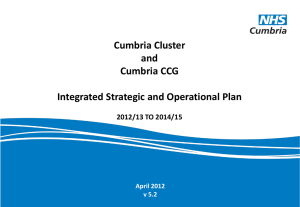Our Annual Operating Plan 2013/14
advertisement
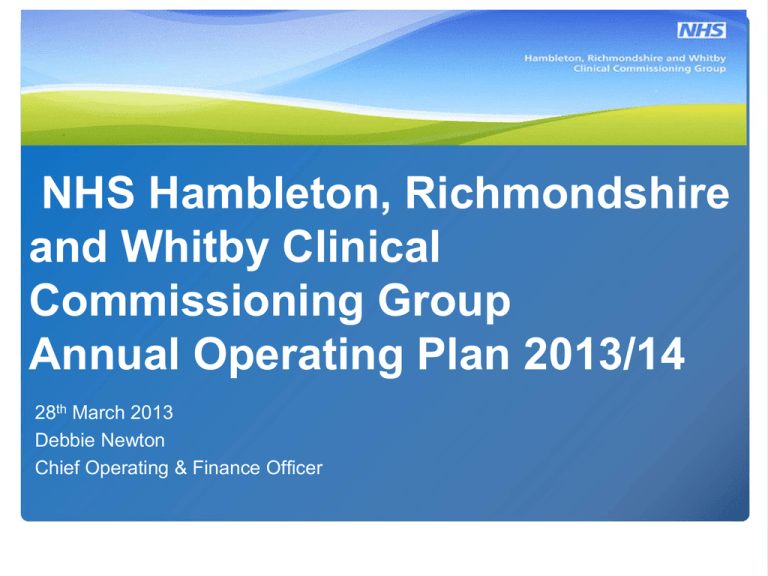
NHS Hambleton, Richmondshire and Whitby Clinical Commissioning Group Annual Operating Plan 2013/14 28th March 2013 Debbie Newton Chief Operating & Finance Officer Our Strategic Plan Strategic aims • We will involve people in their care and we will encourage self-care • We will buy quality services • We will change services for the better and in doing so we will provide care as close to home as possible that is easily accessible • We will use the money we have in the best possible way How did we develop our plan? Our Strategic plan is based on: •Our current performance •What we know about the range and extent of services in our area •Knowledge of local health and social issues through the Joint Strategic Needs Assessment (JSNA) •Knowledge of patient and stakeholder views through JSNA •Department of Health priorities within “Everyone counts” How do our initiatives link to the JSNA? How do our initiatives link to the JSNA? National Commissioning Requirements Everyone Counts • Provides planning guidance, incentives and tools which are intended to improve services from April 2013. • Used by the CCG to ensure delivery of the priorities and requirements which encompasses four key areas: 1. 2. 3. 4. New approaches to planning. Improving outcomes, reducing inequalities. Commissioning support; tools and levers. Planning and assurance. • Two challenges are highlighted below: 1. 2. A guarantee around the reduction of inequality; and ensuring patients’ interests are placed front and centre in delivery of care. Five offers to NHS commissioners, providing guidance and evidence needed to produce better local health outcomes. Everyone Counts: The five offers from the NHS Commissioning Board to CCGs 1. 2. 3. 4. 5. NHS services, seven days a week. More transparency, more choice. Listening to patients and increasing their participation. Better data, informed commissioning, driving improved outcomes. Higher standards, safer care. CQUINS (Commissioning for Quality and Innovation) • CQUIN for 2013/14 is set at a level of 2.5% value for all healthcare services commissioned through the NHS Standard Contract. • Trusts are only eligible to obtain CQUIN payments if they satisfy 50% of the pre-qualifying requirements. • One fifth of the total CQUIN value (0.5% of overall contract value) is to be linked to the national CQUIN goals. • 0.5% of the value for all healthcare services commissioned through the NHS Standard Contract is to be linked to the national CQUIN goals. National CQUIN Friends and Family Test – “How likely are you to recommend our ward / A&E to friends and family” Improvement against the NHS Safety Thermometer (excluding VTE), particularly pressure sores Improving dementia care, including sustained improvement in Finding people with dementia, Assessing and Investigating their symptoms and Referring for support (FAIR) Venous thromboembolism (VTE) – 95 per cent of patients being risk assessed and achievement of a locally agreed goal for the number of VTE admissions that are reviewed through root cause analysis Performance • Contractual levers as set out in the 13/14 standard contract. • National performance measures are in performance indicators delegated to the CCG. • Detailed work to review performance and action plans will take place through our monthly Contract Management Board. • Additional focussed work will continue with providers and patients to ensure the delivery of all ambulance and cancer indicators. The key risks around non-delivery of the Annual Integrated Plan 2013/14 • Capacity and capability. • Demand management. • Impact of Payment By Results Tariff change, specialist commissioning and unbundling of diagnostics. • System wide accountability. • Clarity and credibility of strategic plans. • Finance. • Volume of work transferring to primary care. • Continued patient and public involvement and support. Any significant risk will be added to the CCG Risk Register and therefore result in formal tracking and management. Delivering our Financial Strategy Planning Guidance – what we have to do: Buy safe and sustainable services End the year with a 1% surplus - £1.6m Plan for a contingency of 0.5% - £0.8m Repay share of PCT legacy debt - £1.8m How much money have we got? CCG share of PCT budget Uplift for growth Amount available to spend £’000 165,573 3,808 169,381 How do we agree the budgets? £’000 What we spent in 2013/14 162,563 Efficiencies on provider contracts (-4%) -5,986 Inflation on provider contracts (+2.9%) 4,813 Demographic Growth (+0.72%) 1,105 Other growth and cost pressures 2,581 QIPP Payment to providers for Quality (CQUIN +2.5%) TOTAL EXPENDITURE -2,048 2,977 166,005 Where do we spend the money? What does the bottom line look like? £’000 How much money have we got How much are we spending What have we got left 169,381 -166,005 3,376 What will we use this for? Repay share of PCT legacy debt 0.5% contingency Balance 0.45% surplus -1796 -828 752 Risks to the financial plan • The split of the PCT budgets to numerous organisations – 6 CCG’s, the NHS Commissioning Board and Local Authorities • Demographic growth increases more than expected • Providers cannot meet their efficiency targets • QIPP programme is not fully delivered • Unexpected pressures emerge throughout the year Management Costs £’000 How much can we spend (£25 per head of population) 3,556 Where are we spending it CCG internal costs 1,582 Services bought from Commissioning Support Unit 1,249 Services bought from other support organisations 725 Delivering our Financial Strategy • With the application of growth the CCG’s overall delegated budget for commissioning services in 2013/14 is £169m. • This equates to £1,195 per head of population to spend on commissioning services for its population (Average £1,145). • The full QIPP programme is £2.0m. • After repaying its current share of the PCT brought forward deficit, the CCG is planning to deliver a 0.45% surplus (£752k) at the 31st March 2014, which is below the 1% identified in the national planning guidance. • Gives us a platform to have a balanced financial position next year but this is dependent on mitigating our financial risks. Questions

